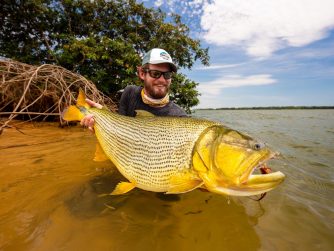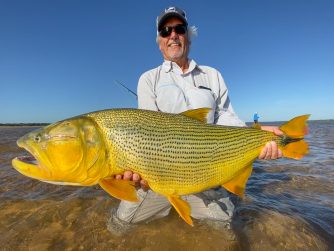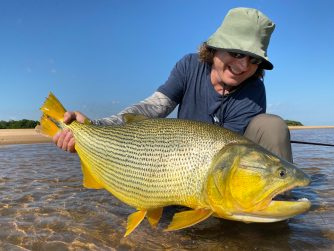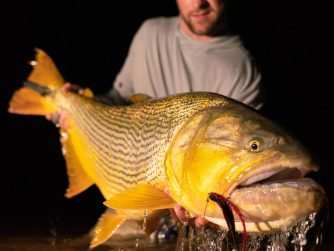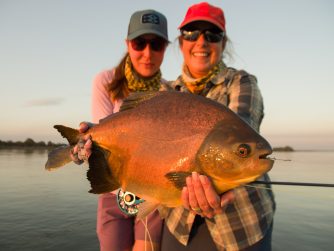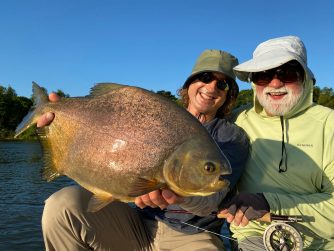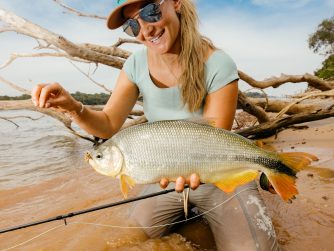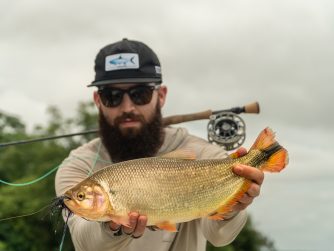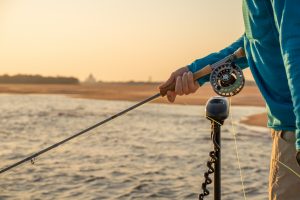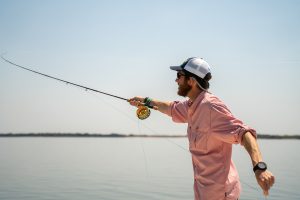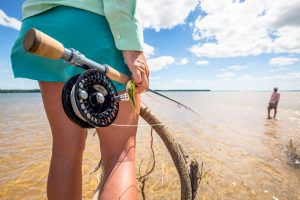Fishing the Upper Paraná
Fishing methods
Suindá Lodge is located on a beautiful section of the Paraná River, home to large dorado, pirá pitá and pacú. There are also great opportunities to sight-fish for these three exotic species. Fishing methods include streamer fishing and plenty of dry-fly action.
The daily program
To avoid the midday heat, anglers generally leave the lodge early in the morning around 6 am or earlier.
Guests return to the lodge for a swim, lunch and drinks at around 10 am. After Lunch and a siesta boats will typically leave the dock around 4:30, returning at dusk. Fishing hours will change slightly depending on the time of year.
Non-fishing activities such as bird watching are available to allow our guests to enjoy the amazing wildlife in the area, and should be organized with the head guide.
The fishing
Dorado
Totally unrelated to the saltwater Dorado (also known as Mahi-mahi or Dolphin), the freshwater Dorado (Salminus brasiliensis) represents the apex of the Charasin family of fish in terms of sport fishing opportunities. Our guides have been exploring the area and Dorado fishing itself for more years than most. Do follow their advice, it will maximize your enjoyment of this incredible fighting fish.
Although the dorado is one of the most exciting gamefish to catch, there is very little written about fly fishing for dorado. Its complex feeding regime and migratory nature ensure challenging and rewarding fishing opportunities for both expert and entry-level anglers.
Dorado are strong and acrobatic—and their pursuit is often more about quality experiences than a numbers game.
Pira Pita
There are two species we target: Brycon Orbignianus and the commonly named in Brazil Piraputanga. Both are, pound for pound, two of the most combative freshwater species. Plus, they take surface flies.
Pacu
Incredibly strong and complex, this omnivorous round shaped fish can provide sight-casting opportunities and great dry-fly action. Not only that, they can get big: 15+ pounders have been caught.
Fly-fishing equipment
Dorado fishing requires casting large flies in hot temperatures. If you think your casting abilities are not up to it or want to take a break during the day, we suggest you bring a casting or spinning rod. Double-hauling is an easily learned technique which will pay dividends when you’re fishing for dorado and elsewhere for other species of fish. It’s important to remember that most of the times your streamer fly must be stripped from the moment it touches the surface of the water. Fast-stripping of the fly is the key to more fish in the boat but it can be tiring after a long day, another reason to bring your casting rods.
- Rods: We recommend bringing 2 or 3 different singlehanded sets of rods to approach the different species. An 9-ft. 8-wt or 9-wt rod to approach dorado with reels carrying tropical floating lines (we recommend tropical RedFish lines or similar). At SUINDA Lodge we fish from floating lines to fast sinking shooting heads for dorado; Intermediate lines can be useful too. An 9-ft. 6 or even 7 weight rod is suggested for Pira Pitá dry fly fishing. Floating tropical lines are a must for our warm weather conditions. We approach Pacu with both 8 and 7 weight rods and fruit patterns; also floating lines are used. We recommend rods from Sage.
- Reels: A quality reel is important. And a strong, smooth drag is a must, as many fish will take long, fast runs. Reels (and spare spools) should have the capacity for the fly line and 100 yards 50-pound backing. We recommend reels from Sage.
- Lines: Pack weight-forward tropical floating fly-lines (redfish, tarpon, and bonefish tapers all work). These lines are used to fish streamers and top-water flies. Also, consider “over-lining” your rods. For example, we often use a 9-weight floating line on an 8-weight rod, which has dual benefits: 1) It makes it easier to load the rod with less line and 2) the heavier line makes casting larger flies easier. Additionally, we recommend bringing fast-sinking line such as a RIO Leviathan (or similar), which has a 26-foot, 300- to 450-grain sinking tip. Sinking Shooting heads from 300 to 450 grains. Intermediate tip lines are good options too, including RIO’s General Purpose Tropical F/I. Note: DO NOT bring conventional cold-water floating lines. Our tropical weather makes them soft and gummy and therefore difficult to cast.
- Leaders: the leaders should be heavy enough to turn over big flies. Spools of mono should include 15, 20, 30, 40, 50, 60 , 70lbs test weights. For floating lines, you should have 9 foot, long tapered leaders. For sinking lines 5-6 feet
of 30 to 50 lb depending on the kind of structure you will be fishing. Mono should work well in most conditions. Maxima Ultragreen Mono is a good option for leader material. An important thing to consider in a Dorado leader is the shock, or bite tippet. These fish have very sharp teeth that will cut even the strongest mono. Bring plenty of 40 to 65 lb test steel leader for your stay. AFW 7×7(American Fishing wire) inmate camo colour is a favorite among our guides. 40 and 65lb test for Dorado and Pacú; and 13 to 20lb test for Pirá Pitá. - Flies: The Lodge provides a wide selection of fly patterns as well as a modest supply of backup tackle at very competitive prices. This notwithstanding, we recommend you bring a good supply of your own flies to get you through your stay.
- Wet Flies: Big Saltwater Streamers are usually the norm. Colors: Black, Black and Chartreuse/Red/ Yellow, Red/Black, Purple and Black with plenty of flashabou. Deceivers traditionally work very well. Other well-known patterns such as Lefty’s Half and Half, Whistlers, CockRoaches and Clouser Minnows are excellent choices as well. Poppers & Divers in similar color patterns have proven very effective in certain conditions. All flies should have a generous quantity of flat, wide holographic flashabou. Weed guards, though not a must, have proven to be quite useful. Size: from 1/0 to 5/0 (mostly 2/0 and 3/0)
- Floating: Large Bombers, frogs, soft foam poppers, pencil poppers, deer hair poppers, Chernobyl ants and large bass or pike bugs. Bring a selection of different colors as the shade is often more important than style. Size: 1/0 to 2/0. For Pacú and Pirá Pita, we recommend fruit imitation flies. Keep your hooks razor sharp. Alto Paraná Lodge strongly encourages the use of barbless hooks.
Spinning and Bait Casting Equipment
- Rods: Whether spinning or bait-casting, use 8-foot rods with a light to medium action (12-18 lbs test).
- Reels: Open-face spinning reels are the easiest to use but, inexperienced hands, bait-casters are the easiest to use accurately and they give you the best chance to place your lure where you want it. Bait-casters should feature a high-speed retrieval ratio, as lures are normally worked very rapidly. Whichever style is your favorite, it will need to be loaded with 40 to 60 lb line.
- Leaders: Steel leaders are a must. Dorado, Pacu and Pira pita have sharp teeth and a 6 to 12 inch, 20 to 65 lb test steel leader is needed.
- Lures: The list is never-ending. Don’t be afraid to bring your own and experiment.
— Spinnerbaits § Spoons from to 1/4 to 2 oz (johnson minous and other models that have weed guard are especially recommended)
— Weedless frog imitations
— Rapala Gliding Rap 12
— Rapala Super Shad Rap 14
— Rapala C Rap 8-10 & 12
— Rat-L-Trap, 1/4-3/4 oz
— Rapala Husky Jerk, 3/4 oz
— Rapala Jointed Minnow (very effective)
— Rapala Original Floating, 3/4 oz
— Rapala Rattlin Rap, 3/8 oz
— Rapala Original Floating, 3/4 oz
— Mepps Spinners, 2, 3 and 4
— Zara Spook
— Hula Poppers
— Slugg-O Plastic Baits
— Jigs from 1/4 to 3/4 oz
— Wood Choppers (and basically any topwater lures with propelers)
Fly Patterns
Dorado Fly Patterns
In most cases, golden dorado prefer dark streamers that produce visible silhouettes. Nevertheless, there are situations when carrying a mixture of brighter colors can be effective. So don’t be afraid to experiment across the color spectrum. All flies should be tied on stout 1/0 to 5/0 hooks. Streamers can be tied from 4 to 7 inches long, or longer. However, it’s important that they’re light enough to cast. For the real big stuff, we recommend hydrophobic materials that shed water and therefore cast farther than water-soaked materials. In order to make your flies more durable, add glue or epoxy throughout the tying process if necessary. Read more
Pira Pitá Fly Patterns
At Suindá lodge, anglers target resident Pira Pitá with lighter tackle than what is typically used for dorado. We recommend 6 weight rods for presenting assorted dry flies. Patterns can represent insects, small fruits that falls from overhanging trees, and even flowers. It is important to choose hooks that are strong and light at the same time for this flies. In addition to drys, we also fish small, bright baitfish imitations and leech-style streamers. Read more
Pacú Fly Patterns
Pacú fishing at Suindá lodge is all about exciting sight-fishing opportunities. We use 7 or 8-weight rods, rigged with floating tropical lines, in order to pitch spun deer-hair “fruit patterns” tied on stout hooks, as well as foam, high-floating dry flies and smaller streamers, toward intended targets. Pacú are omnivores, so fooling them on the fruit, and on top, is sure to please all the purists in the group! Read more

